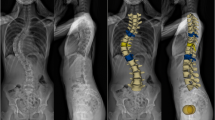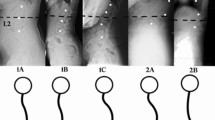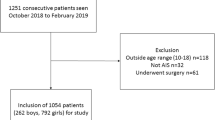Abstract
Study Design
Retrospective measurement of spinal and pelvic parameters in adult spinal deformity patients.
Objective
To correlate spinal and pelvic parameters in adult spinal deformity patients who were in neutral spinal balance.
Summary and Background Data
It is believed that sagittal spinal balance is influenced by both spinal and pelvic parameters, which are closely interrelated as manifested by the reciprocal changes seen when any of the interrelationships was altered. New parameters including proximal thoracic slope (PTS), proximal thoracic tilt, thoracic apical tilt, and coxo-spinal angle (CSA) were studied and correlated with previously studied spinal and pelvic parameters.
Methods
One thousand patients who had undergone standing scoliosis views from 2007 to 2010 were screened. A total of 70 patients, 29 with a diagnosis of degenerative scoliosis and 41 with the diagnosis of adult idiopathic scoliosis, were analyzed for various spinal and spinopelvic parameters. Linear regression analysis was performed.
Results
Thoracic kyphosis (TK) plus sacral slope (SS) had as strong a correlation with lumbar lordosis (LL) (r = 0.871; p <.000) as with pelvic incidence. The ratio LL / (TK + SS) yielded a constant ratio of 0.74 for the balanced spine. Pelvic incidence ± 9 = LL. Lumbar lordosis × 0.74 = TK. Coxo-spinal angle correlated with TK (r = 0.404; p =.000) and CSA / TK yielded a constant ratio in balanced spines. Proximal thoracic slope and thoracic apical tilt strongly correlated with TK (R = 0.793; p = 0.000). Proximal thoracic slope allows introduction of the spinal equation, PTS + LL = SS + TK, which is based on the geometric principle that when measuring angles between 2 horizontal parallel lines the sum of the angles in opposite directions is equal.
Conclusion
The spinal equation may predict ideal spinal and pelvic parameters that may aid in preventing complications such as proximal junctional failure.
Similar content being viewed by others
References
Glassman SD, Berven S, Bridwell K, et al. Correlation of radiographic parameters and clinical symptoms in adult scoliosis. Spine (Phila Pa 1976) 2005;30:682–8.
Schwab FJ, Smith VA, Biserni M, et al. Adult scoliosis: a quantitative radiographic and clinical analysis. Spine (Phila Pa 1976) 2002;27: 387–92.
Glassman SD, Bridwell K, Dimar JR, et al. The impact of positive sagittal balance in adult spinal deformity. Spine (Phila Pa 1976) 2005;30:2024–9.
Booth KC, Bridwell KH, Lenke LG, et al. Complications and predictive factors for the successful treatment of flatback deformity (fixed sagittal imbalance). Spine (Phila Pa 1976) 1999;24:1712–20.
Schwab F, Patel A, Unger B, et al. Adult spinal deformity postoperative standing imbalance. Spine (Phila Pa 1976) 2010;35: 2224–31.
Lafage V, Schwab F, Vira S, et al. Spino-pelvic parameters after surgery can be predicted: a preliminary formula and validation of standing alignment. Spine (Phila Pa 1976) 2011;36:1037–45.
Jackson RP, Hales C. Congruent spinopelvic alignment on standing lateral radiographs of adult volunteers. Spine (Phila Pa 1976) 2000;25:2808–15.
Lafage V, Schwab F, Patel A, et al. Pelvic tilt and truncal inclination: two key radiographic parameters in the setting of adults with spinal deformity. Spine (Phila Pa 1976) 2009;34:E599–606.
Vialle R, Levassor N, Rillardon L, et al. Radiographic analysis of the sagittal alignment and balance of the spine in asymptomatic subjects. J Bone Joint Surg Am 2005;87:260–7.
Bernhardt M, Bridwell KH. Segmental analysis of the sagittal plane alignment of the normal thoracic and lumbar spines and thoracolumbar junction. Spine (Phila Pa 1976) 1989;14:717–21.
Legaye J, Duval-Beaupere G, Hecquet J, Marty C. Pelvic incidence: a fundamental pelvic parameter for three-dimensional regulation of spinal sagittal curves. Eur Spine J 1998;7:99–103.
Kobayashi T, Atsuta Y, Matsuno T, Takeda N. A longitudinal study of congruent sagittal spinal alignment in an adult cohort. Spine (Phila Pa 1976) 2004;29:671–6.
Roussouly P, Pinheiro-Franco JL. Sagittal parameters of the spine: biomechanical approach. Eur Spine J 2011;20(Suppl 5):578–85.
Kim YJ, Bridwell KH, Lenke LG, et al. An analysis of sagittal spinal alignment following long adult lumbar instrumentation and fusion to L5 or S1: can we predict ideal lumbar lordosis? Spine (Phila Pa 1976) 2006;31:2343–52.
Rose PS, Bridwell KH, Lenke LG, et al. Role of pelvic incidence, thoracic kyphosis, and patient factors on sagittal plane correction following pedicle subtraction osteotomy. Spine (Phila Pa 1976) 2009;34:785–91.
Lafage V, Ames C, Schwab F, et al. Changes in thoracic kyphosis negatively impact sagittal alignment after lumbar pedicle subtraction osteotomy. Spine (Phila Pa 1976) 2012;37: e180–e187.
Di Silvestre M, Lolli F, Vommaro F, et al. Proximal junctional kyphosis after posterior fusion for adult scoliosis: is there a correlation with pelvic incidence? Paper presented at: Scoliosis Research Society Annual Meeting; September 5—8, 2012; Chicago, IL.
Author information
Authors and Affiliations
Corresponding author
Additional information
Author disclosures: DD (none); AB (none); PV (none); GM (consultancy and expert testimony for confidential sources; grants from CDC, NIH); KW (none); BR (none); JM (none); ST (consultancy for Biomet, Synthes; payment for lectures including service on speakers bureaus from Biomet, Synthes; travel/accommodations/meeting expenses from AO-Spine; other support from AOSpine Fellowship support).
Rights and permissions
About this article
Cite this article
Deinlein, D., Bhandarkar, A., Vernon, P. et al. Correlation of Pelvic and Spinal Parameters in Adult Deformity Patients With Neutral Sagittal Balance. Spine Deform 1, 458–463 (2013). https://doi.org/10.1016/j.jspd.2013.08.005
Received:
Revised:
Accepted:
Published:
Issue Date:
DOI: https://doi.org/10.1016/j.jspd.2013.08.005




